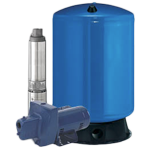Well Pumps

Inside the nose of a shallow well jet pump there is a nozzle and venturi pair. The nozzle blows water through the venturi which creates a pressure differential. It’s this pressure differential that actually helps the pump build pressure. It’s kind of the same physics principal used in a jet engine. Jet pumps are mounted above the well, either in the home or in a well house, and draw the water up from the well through suction. Because suction is involved, atmospheric pressure is what's really doing the work. Think of the system as a long straw. Jet pumps come in both shallow and deep well versions.
Submersible well pumps take the pumping power to the source, down the well. A typical submersible pump is characterized by a long cylindrical shape that fits inside the well casing. The bottom half is made up of a sealed pump motor that is connected to the above-ground power source and controlled by wires. The actual pump half of the unit is comprised of a stacked series of impellers, each separated by a diffuser, that drives the water up the pipe to the plumbing system. While submersible pumps are more efficient than jet pumps in delivering more water for the same size motor, pump or motor problems will necessitate pulling the unit from the well casing-a job that's best left to a pro. However, submersibles are known for their reliability and often perform their role 20 to 25 years without servicing. Submersible pumps may also be used in shallow wells. However, silt, sand, algae and other contaminants can shorten the pump's life.
Because each well has unique characteristics, let the experts at Laux Plumbing, Heating & AC, Inc. help explain all the details and customize a solution that's right for you.

